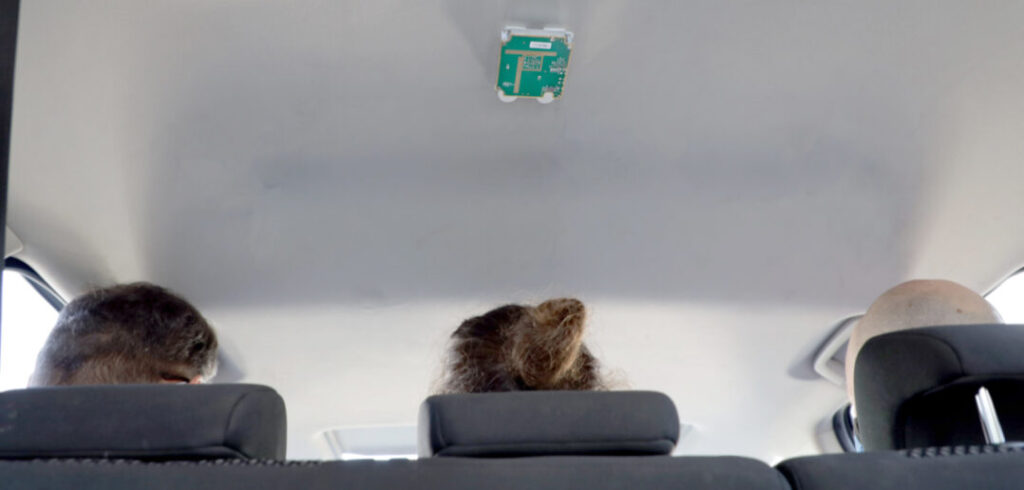4D imaging radar specialist Vayyar has developed what it claims is the world’s first automotive sensor that covers the entire cabin of any passenger vehicle, with a single Radar-on-Chip (RoC).
Given the 60% growth in global consumer demand for SUVs over the past five years, Vayyar’s production-ready in-car sensor is designed to cover up to three rows. It is also designed to accommodate the rapidly growing number of cars with sunroofs, thanks to uniform rear ceiling installation. Monitoring every seat, all footwells and the open trunk area, the sensor represents a breakthrough safety solution, protecting the most vulnerable vehicle occupants, the Israeli company says.
Up to 200 children die each year from vehicular heatstroke after being left unattended in cars. These tragedies can occur in minutes since on days as cool as 22°C, the inside of a car, especially one equipped with a sunroof, can quickly reach 47°C.
“With SUVs making up over 40% of vehicle sales in many countries, complete cabin coverage is crucial,” explains Ian Podkamien, VP and head of automotive at Vayyar. “Three-row CPD solutions for all vehicles, including those with sunroofs, will help prevent ‘hot car’ incidents, while enhanced SBR will save thousands more lives by ensuring that all passengers wear seatbelts. And with just one affordable sensor for both functions, high-end safety is now available to all vehicles.”
Vayyar’s full-cabin sensor is fully operational in all lighting and weather conditions and maintains privacy at all times, since no cameras are involved. The ultra-wide field of view and high resolution provided by the 48 transceivers in each Vayyar sensor enable the platform to support multiple advanced applications simultaneously, while replacing numerous single-function sensors.
Given the cabin size of SUVs and the fact that parents of young children comprise the majority of SUV owners, three-row coverage is a critical aspect of in-car sensing. Alternative solutions require two to three single-function sensors to cover the entire cabin of an SUV, driving up the cost and effort associated with providing safety in larger vehicles, according to the company.
Until now, vehicles with sunroofs have also presented unique challenges in terms of in-cabin sensor positioning. With no option of fitting a sensor in the center of the ceiling, manufacturers had to make do with sub-optimal installation options. Now OEMs can install just one Vayyar sensor in the rear ceiling area, covering the entire interior of any passenger vehicle, with or without a sunroof.
Vayyar offers OEMs and Tier 1 suppliers a flagship Child Presence Detection (CPD) and enhanced Seat Belt Reminder (SBR) combo, essential for meeting Euro NCAP’s more stringent 2023 and 2025 safety scoring protocols. The platform does so by detecting occupants, classifying children and adults, and detecting posture and position.
The robust, automotive-grade solution also goes beyond just CPD and SBR, according to the company. Addressing the most challenging Euro NCAP safety requirements, Vayyar’s AEC-Q100 qualified and ASIL-B-compliant platform provides vehicles up to 10 in-cabin points for 2023 onward.
By providing multifunctionality on a single-chip platform, the company hopes to enable auto makers to move past the ‘one sensor per function’ legacy industry approach. Uneconomical and unsustainable, this has traditionally burdened vehicles with more wiring, hardware, software, SOP programs and integration efforts, at significant extra cost, it claims.
Instead, Vayyar says its data-rich 4D Point Cloud Application Programming Interface (API) enables customers to independently develop and deploy numerous additional safety features over its point cloud layer. These may include Occupant Status (OS), optimized airbag deployment and dynamic disabling, seatbelt pre-tensioning, eCall, gesture recognition, out-of-position detection, intruder detection and other applications.
The platform also supports over-the-air (OTA) software updates, allowing auto makers to scale to new features long after a vehicle has left the production line.
“With a similar price point to an alternative radar sensor, or a standard ECU, Vayyar’s affordable technology is driving a paradigm shift that’s enabling economy vehicles to feature the exceptional safety offered by high-end models,” concluded Podkamien.
“In SUVs, safety is particularly challenging because of the complexity required to support their larger cabin area. Multifunctionality on a single-chip platform is instrumental in providing enhanced safety without additional hardware, reducing complexity and saving the cost of multiple sensors per seat.”



